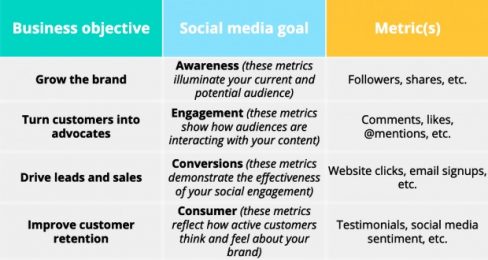Social media is a constantly evolving world of its own. If you don’t stay in touch with the latest trends, you’re out of the game. And these trends change by the minute. To help you create a powerful social media marketing strategy here’s a tried and tested guideline:
- Assess your current marketing strategy
To find a solution, you need to identify the problem. The first step in creating a successful marketing strategy is to pinpoint all the areas that aren’t doing well. You’ll require analytical tools to measure your business’s annual performance. Here’s an example:

Source: Sprout Social
You’ll notice that the response rate can be improved. You’ll also notice that the average response time is too high. In this situation you’d need to revamp your customer representative team i.e. retain efficient workers and ensure you have enough employees to cater to customers.
Similarly, you need to analyse important areas including:
- Follower growth (if any)
- Customer engagement
- Customer reach through posts
- Click-through rate to assess customers’ website experience
- Mentions and hashtags to assess overall brand reputation
Once you’ve audited your social media performance, dig in deeper to understand the root cause of the problem.
Suppose you’re not reaching the desired amount of audience through your posts. This could be because your content is not engaging enough or your customers are not active on the platform. Either way, it’s a simple fix which can improve your web traffic as long as you determine the accurate cause.
- Establish the most significant metrics and set your goals accordingly for the best social media marketing results
Don’t waste your time on tracking metrics such as page likes and retweets. They’re easy to track but they don’t measure real performance. Here’s a few of the essential metrics that you should look out for in 2019:
- Sentiments: In this case, Facebook makes your job a lot easier. If you get angry reacts on your posts, it could be an indicator that your post was offensive and you need to do damage control. Make sure your audience’s sentiments are in your favour.
- Organic and paid likes: Instagram can be your best friend when it comes to organic likes. It’s harder to track organic likes on Facebook than on Instagram. Plus, paid likes will not measure customer engagement as effectively, although it can boost it.
- Hashtag performance: You can learn a lot about your brand reputation from hashtags. Were they reposted against your content or in favour of it? Hashtags measure engagement as well as brand association, so try to make sure they’re associated with your business in a positive way.

Source: Market Assist Blog
- Monitor your competitors
There’s an easy trick to finding out how who your direct competitors are. Suppose you’re setting up a donut shop. Just type a search on Google for the best donut shops in the area. There’s your competition! For a detailed approach, you can always use competitor analysis tools.
But why is it important to keep an eye on competitors? Because you need to stay updated with all the latest industry trends. For example, anywhere in the food industry, you’ll notice Lotus is all the rage. So whether you sell donuts, ice cream, cakes or any other dessert – add a Lotus flavour. Not only would you be engaging customers with new and exciting flavours, you’ll ensure you stay ahead of your competitors.
Another reason why you should know what your competitors are up to is because it helps you better understand how they interact with their audience, and thus, how you should interact with yours. Plan your strategy accordingly; however, make sure you don’t steal or copy any ideas. This is what marketers call social media listening.
- Get acquainted with your audience
If your products are targeting the elderly, is it really wise to use social media as a form of marketing? Only 32% of senior citizens aged 65 and above reported to using social media platforms. Even if you go by the book and do everything right, if you don’t have an audience, it won’t matter!
Divide your target audience into segments. For a conglomerate like Samsung, this can be done in several ways. Samsung’s smartphone division can divide its users based on their buying patterns i.e. Galaxy S series, Note series, Galaxy A series etc as most users are loyal purchasers of one series. The company can also divide them based on purchasing power i.e. target social media paid ads of its high-end phones to customers with high purchasing power. Similarly, ads can be used to target price conscious customers with budget friendly phones. When you target the right people, your conversion rate will go up and you’re likely to make a significant amount of revenue.
Here’s an example of how a tech company like Samsung can segment its users:

Source: WordPress
Luckily for you, social media analytical tools will do the work.
- Figure out where to post your content

Source: Social media logos BW
If you know your audience, it’ll automatically help you decide where to post your content. For example, since the most widely used platform for senior citizens is Facebook, that is where you want to advertise. Selling them insurance or memberships on Instagram or Twitter is probably not going to be so effective. To figure out where to post your content, you’ll need to determine the purpose of each platform:
- Twitter: It’s best to use Twitter only for news purposes. Focus on trending topics and hashtags.
- Facebook: This is the platform with the highest amount of traffic still, so take advantage of that. Use Facebook for entertainment and news but keep your content light and entertaining. Videos perform the best here.
- Instagram: When dealing with visuals, use Instagram. Pictures, videos, and short quotes will all perform well here.
- Pinterest: Again, this platform is great for visual content (mostly pictures). Since users of this platform look for inspiration here, make sure you give them just that.
- Linkedin: This is a great platform where you can find as well as share industry data.
Important: Choose quality over quantity. You don’t have to market through every social media channel. Instead, choose the best social media channel that your customers are most active on and focus on those to provide meaningful content. This will save you time and help you run your business efficiently.
- Provide speedy services
Time is of the essence when you’re dealing with customers. In this generation, customers want two things: not only a speedy response but also a meaningful conversation. They will appreciate a customer representative dealing with them rather than a robot, be it on call or via text.
If you’re in the food industry, you’ll need a customer representative team around the clock. From when orders are being prepared to when they are delivered, there is only a short amount of time and customers have a million questions. The average response time should be within minutes, so especially during rush hours, you need to make sure you have an appropriate amount of representatives available to deal with customer concerns. Moreover, a bit of automation doesn’t hurt. If a customer representative isn’t available, an automated message can be sent out so that the customer remains at ease. While it doesn’t generate revenue directly, good customer service can go a long way in retaining customers and creating a strong brand reputation.
Furthermore, it is not just about dealing with customers via Facebook Messenger or Instagram DMs anymore. You need to allow customer representatives to specific tasks through which they engage with customers. Make sure your business makes the effort of interacting with customers in the comments section under posts – responding to queries, clearing any doubts, or generally making conversation. Here’s an example:

Source: Later
- Make sure your content is engaging
This will require a lot of creativity, especially in this era where you need to create the perfect balance. 46% of users have reported that they will unfollow a brand if it posts too much, whereas 41% of users claim that they will unfollow a brand if it does not post enough. There can be a lot of pressure on brands when it comes to this. Luckily, there are 2 things you can do:
- Post video content: Are you familiar with Tasty? Their mesmerizing food videos are the sole reason behind their success today. Take a look: https://www.facebook.com/pg/BuzzFeedFood/videos/
If you played this video, I’m sure you watched it till the end. It’s this kind of content that you need to create, which makes customers not want to miss even a second!
- Repost customer content: Customer-generated content is a great way to increase your following and get people to trust your brand. Simply reposting a customer or blog’s good review will make other users want to try your brand.

Source: HootSuite Blog
- Choose the frequency and timing of your posts
You can’t overwhelm your customers with so many posts because it’ll only make them lose their value. In addition to that, there are a few peak hours for each platform which will get you maximum reach. Here are a few examples:
- Facebook: Post between the hours of 12-4 PM on Wednesday, Thursday and Friday
- Twitter: Post around 12 PM on weekdays
- Linkedin: 5-6 PM on a Tuesday, Wednesday and Thursday
- Instagram: Key timings include 11 AM-1 PM on a Monday, Wednesday, Thursday and Friday
For more, read: Best times to post on social media
Switch to automation
To save yourself time and gain accuracy, you can schedule your posts. Most platforms have algorithms that allow you to preschedule when your post will upload. Here’s how Facebook does it:

Source: Louis Myers Visual Social media
- Test, improve and implement your strategy
No matter how well you plan, there are some things that you can evaluate better only after they have been implemented. Nothing is perfect, so don’t expect your social media strategy to have no flaws in the first try. Test it out – see what works and what doesn’t. Re-evaluate your strategy accordingly and update it frequently.
Track results
Using analytical tools like UTM Parameters can help you see how much web traffic each post drives. By doing this, you’ll be able to better determine what to keep in your strategy and what to remove.
So that was a complete guideline on how to create a powerful social media marketing strategy. It’s not an easy job, but the key is to keep updating and improving it frequently. You also need to keep up with the latest technology and trends because they will make your work a lot easier. Keep an eye on emerging trends and incorporate them into your strategy wherever necessary. Want more tips on how to leverage social media? Learn more about how you can boost your SEO through social media marketing.
